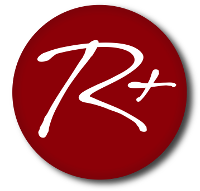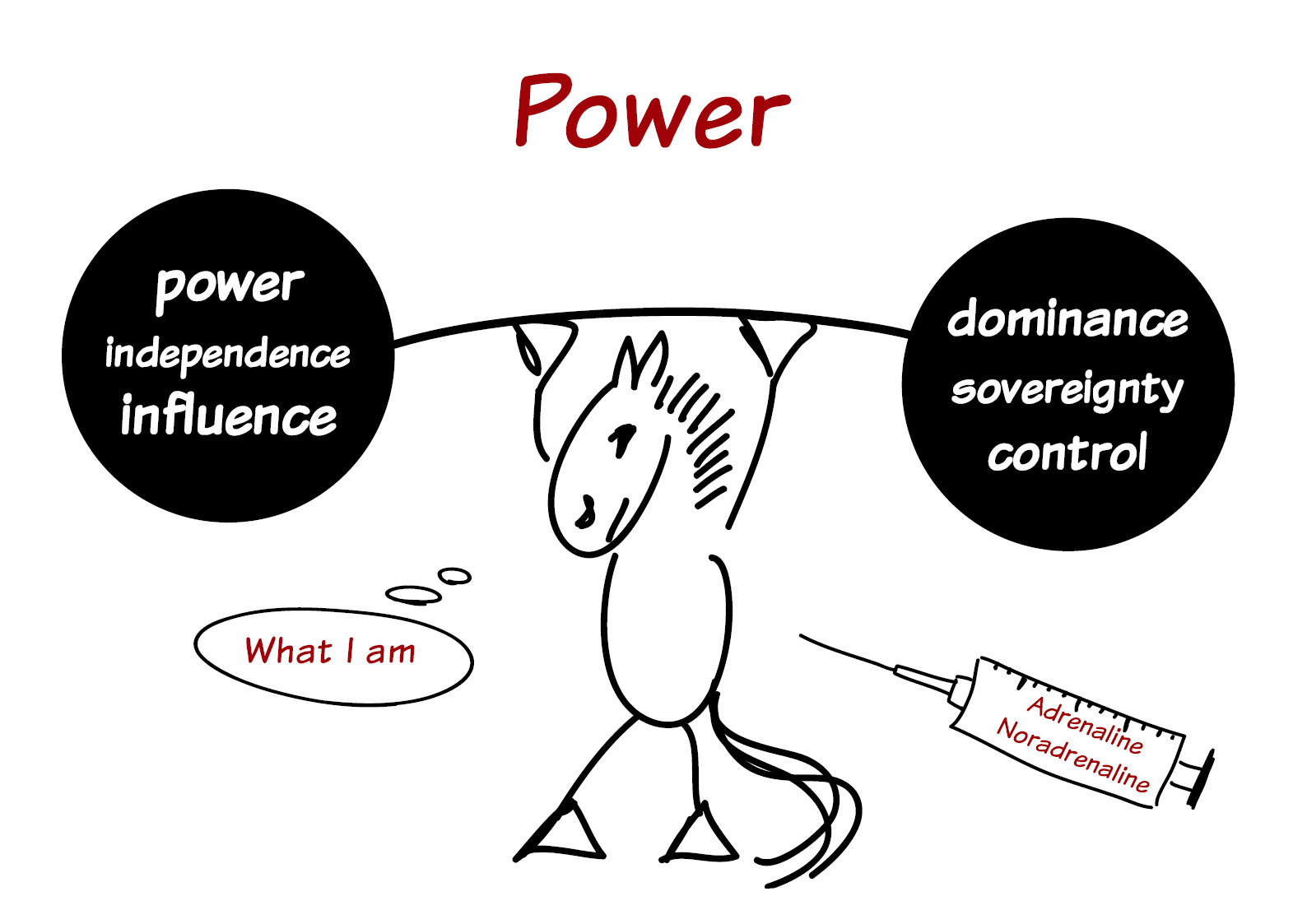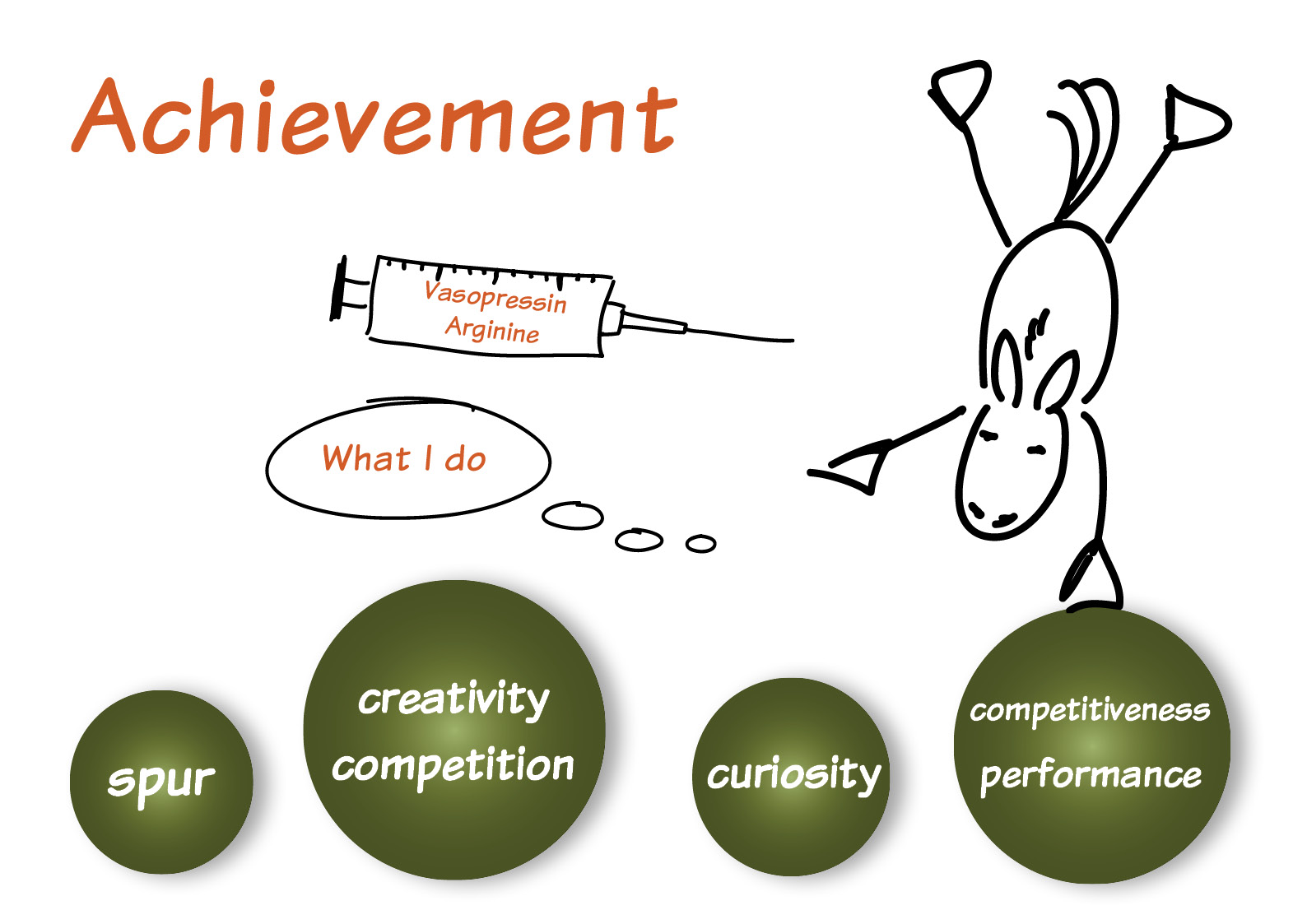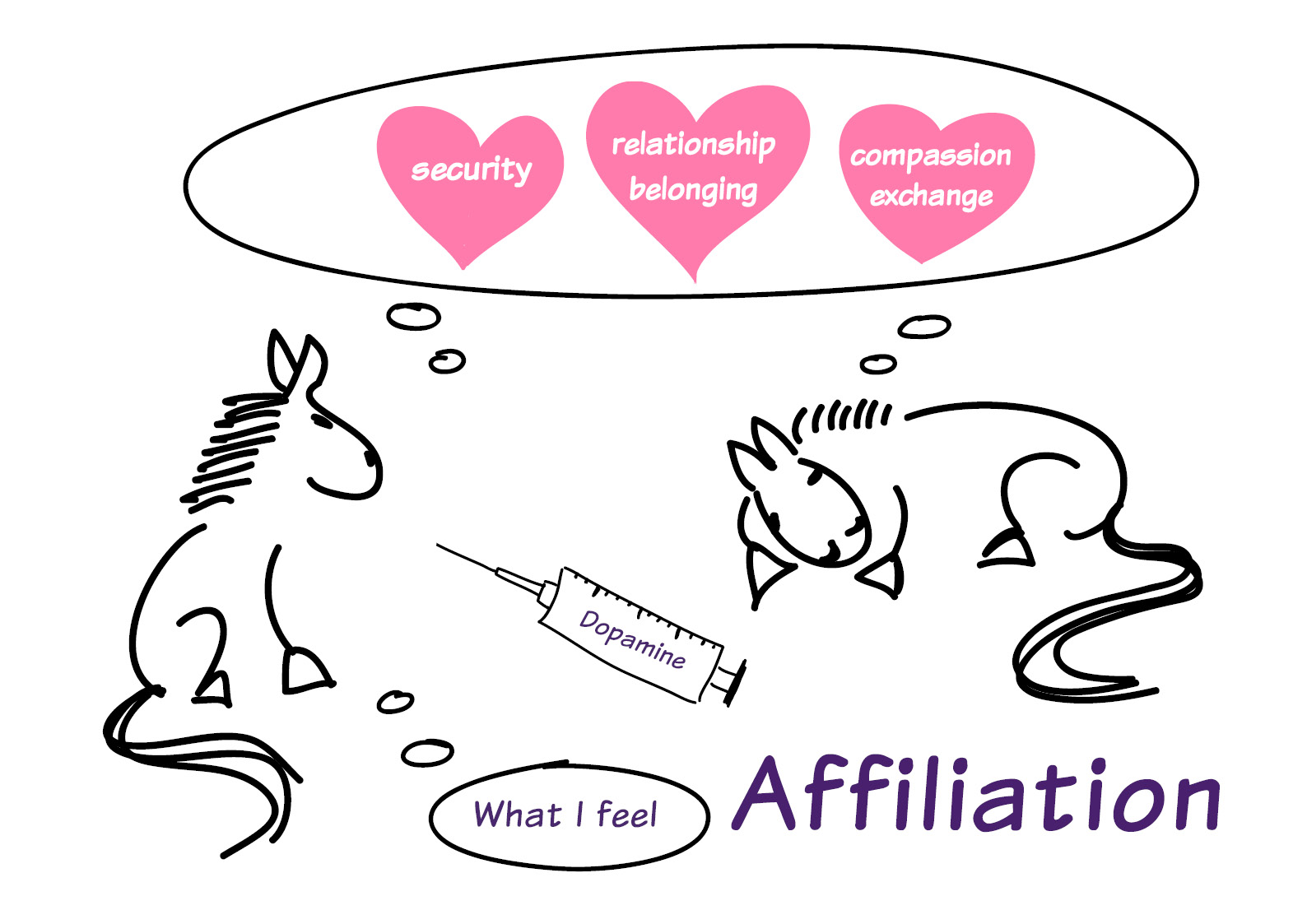Sources of motivation
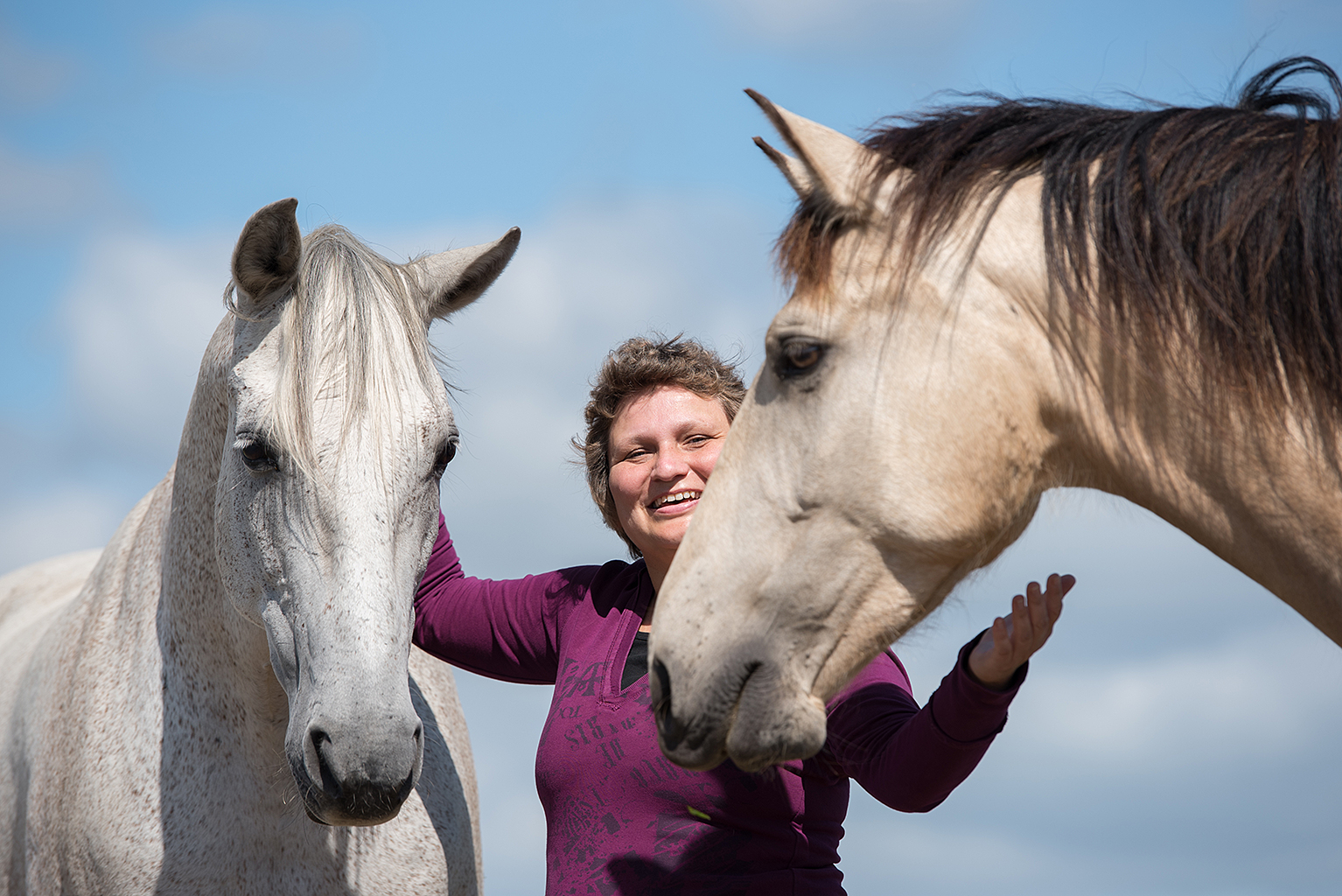
We all are someone!
Sooner or later we all ask ourselves the same questions, where do we come from, where are we going and what motivates us. Who are we really, and how does our and our horse’s personality come into being in the first place?
We can learn so much about our daily struggles but also about what we gain through our relationship with horses if we trace the main motives of what motivates us to act. Then, we begin to understand the unique form of connection that comes to life when humans and horses truly interact.
We examine personality structures.
Who are you?
Who is your horse?
And what about the two of you?
What characterizes your “WE”?
Have you ever asked yourself why some lessons are learned effortlessly while other just won’t work? To better understand why this happens we’ll give you a glimpse of our approach today:
Consider
I found it extremely helpful in my practical work with horse-human-teams to explore how different personalities can be motivated best. Thinking about main motives, so to say the characteristic stimuli of individuals, goes far beyond asking how to reward specifically or which training method to use.
Investigate needs
Exploring the key needs can help to see both sides, human and horse, more clearly, and understand why communication works perfectly right from the start in some couples and is more difficult to establish in others. So, let’s investigate the different personalities of humans and horses.
Who are you?
I ask myself “Who are you” every time I meet humans or horses I haven’t met before. The work of American psychologist David McClelland is my underlying base for thinking about the personal characteristics of different individuals
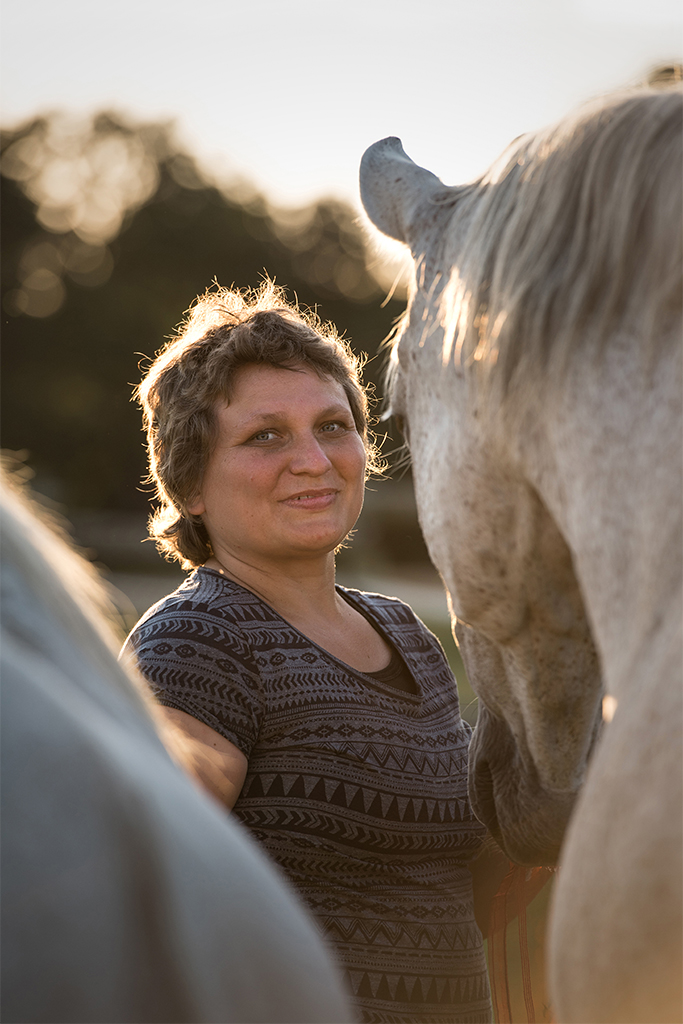
Sources of motivation according to McClelland
Traditionally his theory of achievement motivation refers to human beings and aims to empirically investigate a person’s key needs and motives. So, it is not about listing and decoding all kinds of needs an individual might have but about defining the unique and traceable key needs of an individual personality. According to his theory there are three universal key needs that apply to all human beings, the “big three”. In my opinion they also apply to horses due to the anatomical equality of structures in the brain and nervous system of humans and horses. The “big three”, power, achievement and affiliation, will be explored in the next section.
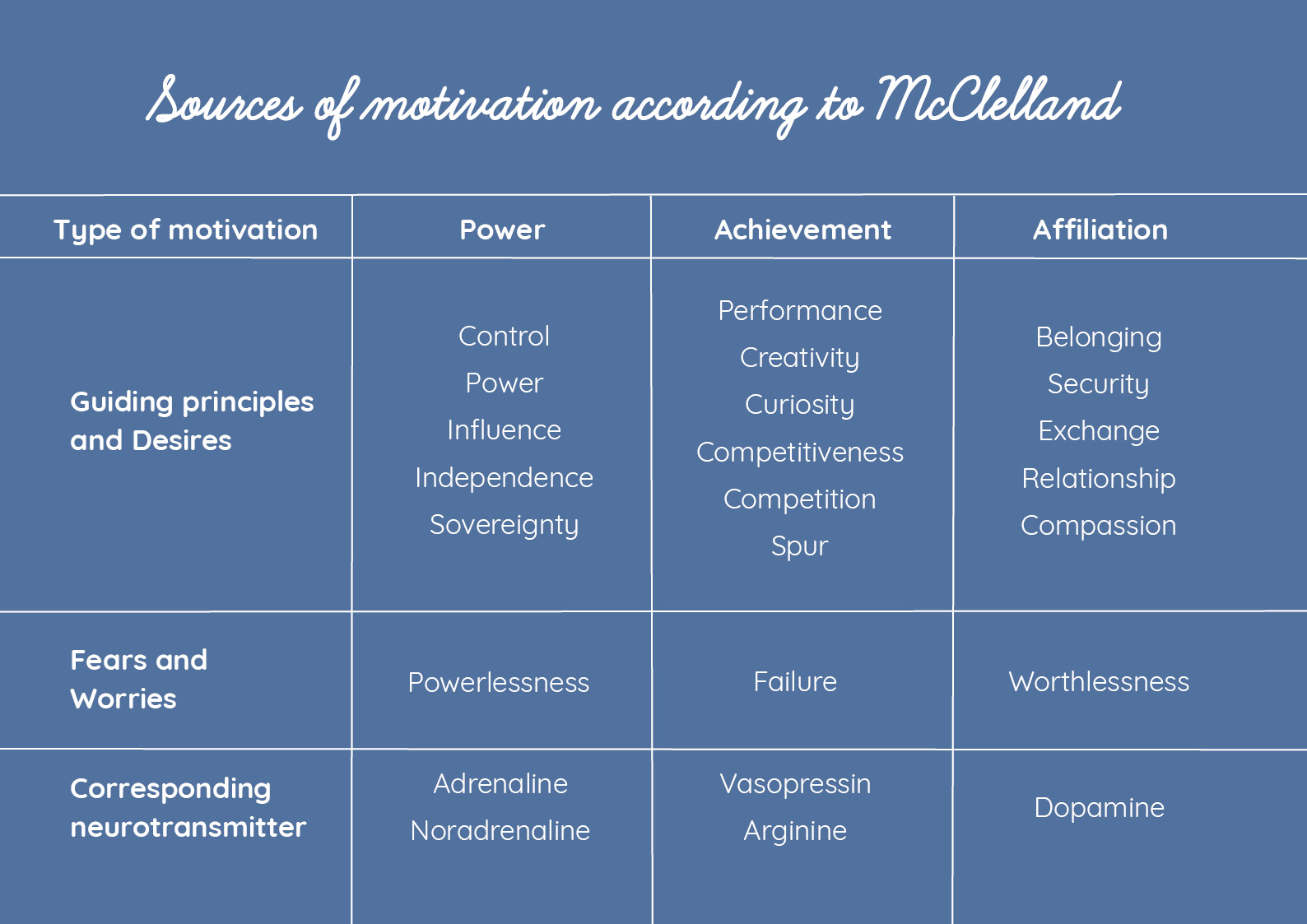
Influence on behavior
These three basic motives have a particularly strong influence on our actions, and can be understood as internal source of energy that makes goal-oriented behavior possible in the first place. In general, behavior is strongly influenced by the consequences it triggers; either in positive form, e.g. praise and affirmation or in negative form, e.g. disciplinary action or punishment. Yet, behavior is also affected by one’s individual inner needs. They are an effective force strongly connected to the aspect of intrinsic motivation, or in other words they have huge influence on the forms of behavior humans and horses are going to love and develop of their own accord. The strong influence of these basic motives has been substantiated through several studies by McClelland and his colleagues since.
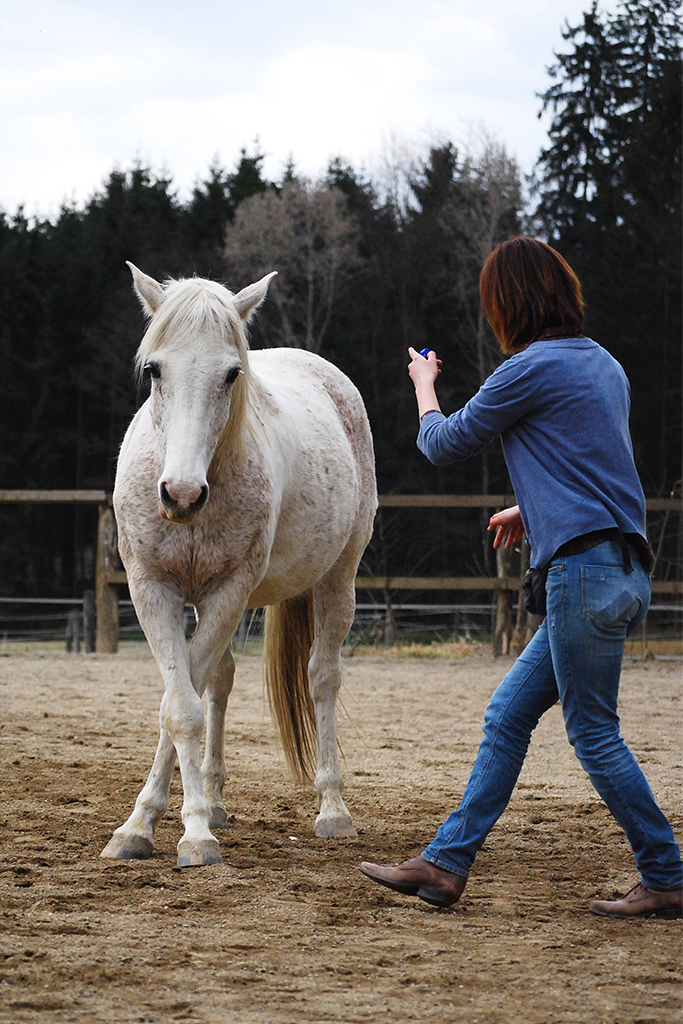
Brain metabolism
Additionally, results from recent research in cerebral metabolism show that each of the three basic motives is connected to specific messenger substances in the brain which can be distinguished from each other. So, there is neurophysiological evidence that underpins the difference of the three motivational factors affiliation, power and achievement.
The full range of our basic motives forms the rainbow of our common life.
In each case different neurotransmitters are being released and each of them is related to different feelings. Therefore, it makes a difference which motive is stimulated.
Driving force behind feelings
Specific feelings are elicited when certain motives, wishes or hopes are satisfied; and typical fears and worries are stimulated if one of the three basic motives is weak or lacking. So, the emotional feelings of certain personality structures differ in humans as well as in horses; very pronounced power motives lead to completely different feelings when compared to strong motives of affiliation or achievement.
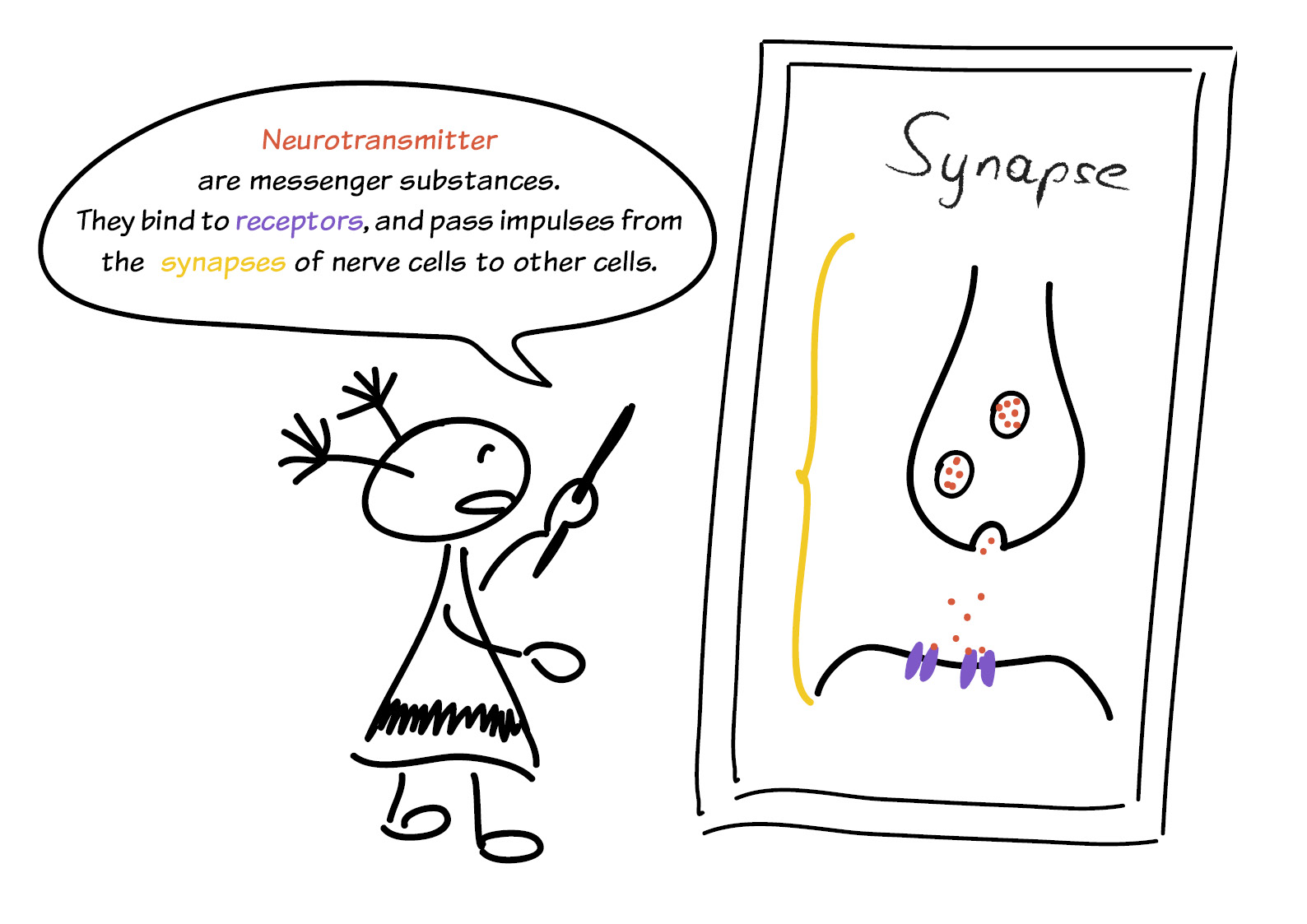
The “big three” in practice
Amongst other things, McClelland wanted to answer why some human beings feel called to become pedagogues or actors while others prefer to become team players or managers. Horses also show these traits and some are born show talents whereas others feel most comfortable acting more socially as part of the herd.
Perceive needs
According to McClelland it is necessary to examine the specific weighting of the three basic motives in a certain being in order to find out who can be motivated best in which way, and which motive can be used best to stimulate a certain being’s behavior. All three key needs of “the big three” are active at all times in humans and horses alike. What is really interesting is how they differ individually, for example, how the power motive acts in relation to the affiliation motive if we compare a stereotypical corporate manager to a typical kindergarten teacher. Next, I want to treat all three key needs or each component of “the big three” individually to illustrate how I deal with them in my work.
Zap through Curly’s achievement motives!
The basic motives as sources of energy
We will be able to understand why some people prefer certain tasks, and why they fulfill them quickly and reliably while others need an awful lot of time to do the same, and feel terribly bored in this process if we regard the three different basic motives as sources of energy for goal-oriented behavior.
Similarly, individual human reactions to making mistakes, finding approval or being restricted can teach us about the personality structures of horses, and can thereby indicate the probability for receiving certain reactions in the future.
The lust for power
A strong need for power is related to a desire for “control, dominance, importance, social status, influence, combat, or prestige”. I put these terms in quotation marks because they are descriptions and definitions from human psychology and we should only use them with caution when speaking about horses.
Autonomy
However, they can help to illustrate how a being with a strong power motive will likely act: Particularly, such a being wants to be perceived, and needs the feeling of being involved in decision-making or even better needs to be able to decide for him-/herself and thereby feel “important”. Autonomy is a central topic for individuals with a very pronounced power motive, and they find orientation within themselves or in other powerful beings. In my opinion, the term “power” is strongly related to the term “force” because these motivational types are largely driven by a strong inner force to prove themselves. They are able to assert themselves, are uncompromising, and they do not mind standing up for what they believe even if they are alone in doing so.
Biochemical processes
Not recognizing the power motive results in feelings of impotence. Catecholamines like adrenaline and noradrenaline, also known as stress hormones, are inextricably linked with the power motive. These messenger substances play an important role in the body’s “activation processes”, for example, they are involved in mobilizing your forces to deal with stress.
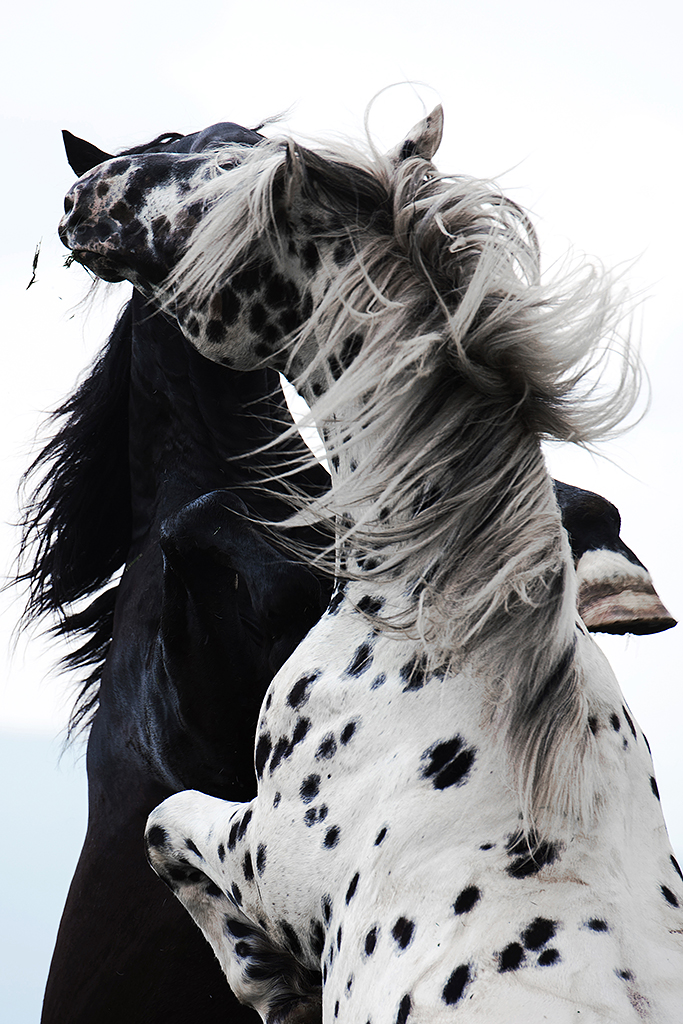
Messenger substances as activators
The secretion of adrenaline and noradrenaline, for instance, lead to an increased heart rate, and thereby provide better blood flow to the muscles but also inhibit the digestive activity of a body. Therefore, personalities who are characterized by a strong influence of catecholamines are quick to respond, concentrate fully on their work, and are determined and goal-oriented. In other words, they quickly switch to working mode, and ideally, switch back to relaxation mode just as fast.
Among human beings many managers, politicians but also teachers belong to this group. They enjoy retaining and using the levers of power. Literally speaking, they enjoy holding the reins, and prefer acting to reacting.
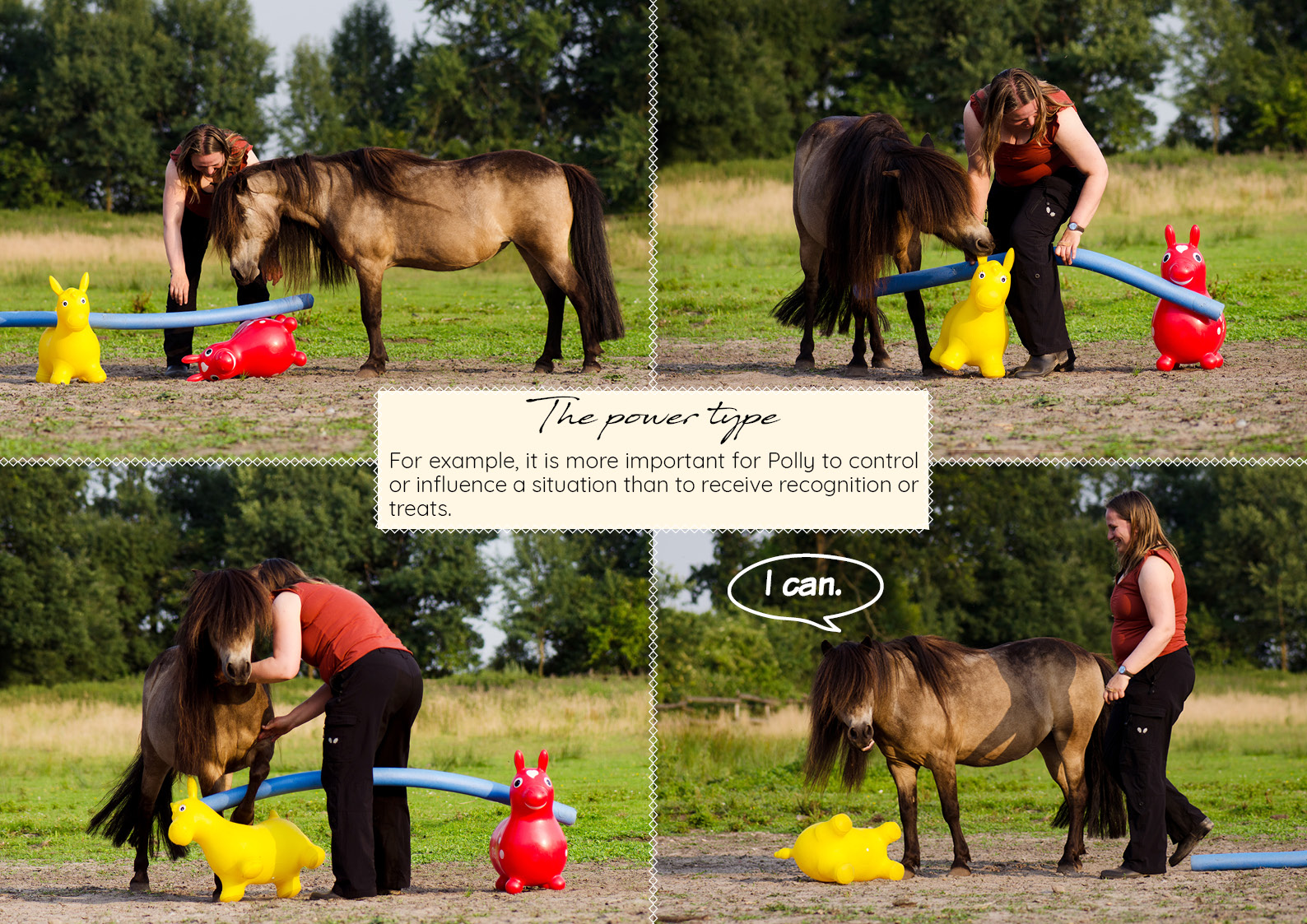
Striving for achievement
Horse personalities that can be labeled as driven by the achievement motive show a pronounced urge for “variety, curiosity, fantasy, creativity, progress, and success”. Again, these terms should be considered as rather fuzzy descriptions in quotation marks, and they should only serve to spark your imagination so you might be able to picture a correspondent horse personality; this list is by no means exhaustive or corresponds directly to horses.
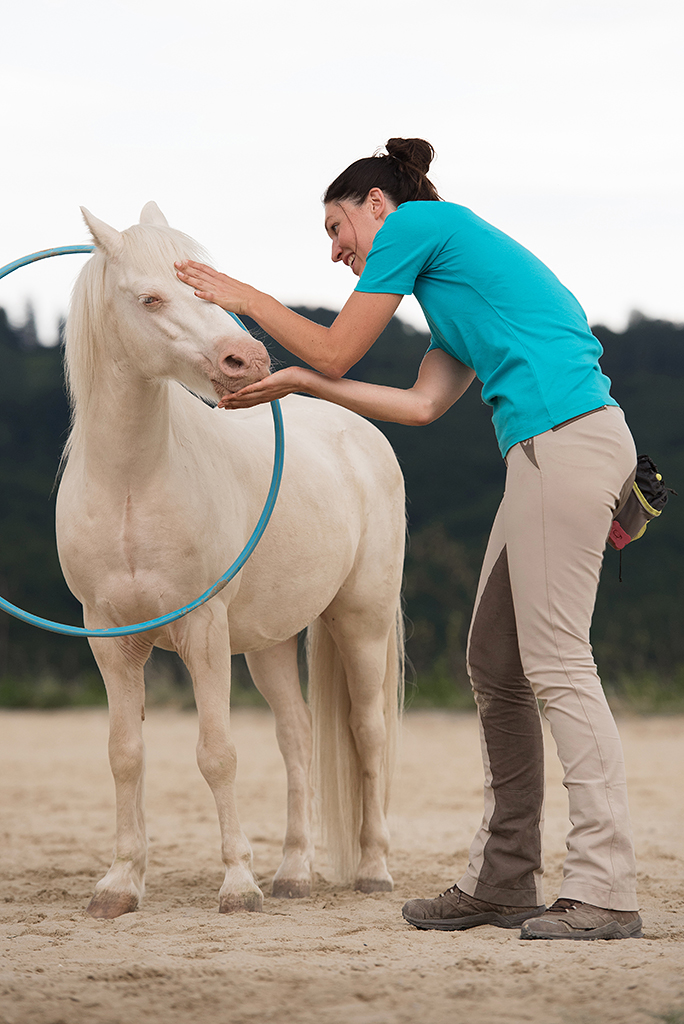
Your own effort’s result
Individuals who are strongly governed by the achievement motive strive for challenging and stimulating goals. They are willing to take risks to achieve their objectives, accept making mistakes in this process, and they do not take it personally if you correct them but consider this valuable information. They are interested in perfecting the moment, in the work itself, and in their own endeavor’s product. Quick and direct feedback is necessary and important for them so they are able to assess the value of their achievement. They enjoy being assessed, and thereby recognized by others, and they simply love being celebrated for a great performance.
You are what you feel
The central topic in the lives of individuals under a strong influence of the achievement motive is to achieve something extraordinary. Fears and worries result from this motive and can best be labeled under descriptions such as weakness, humiliation, incapacity or futility. They are all related to feeling the fear of failing.
Biological helpers
Two hormones are inextricably linked with the achievement motive; first the peptide hormone vasopressin, and second the antidiuretic hormone (in short ADH) which is increasingly secreted when this basic motive is excited. ADH plays an important role in the body when someone is dealing with stress because of its vasoconstrictive activity which increases blood pressure. It has a strong influence on the regulation of feelings of thirst, and supports memory performance. Among humans many entrepreneurs and competitive athletes are strongly influenced by the achievement motive.
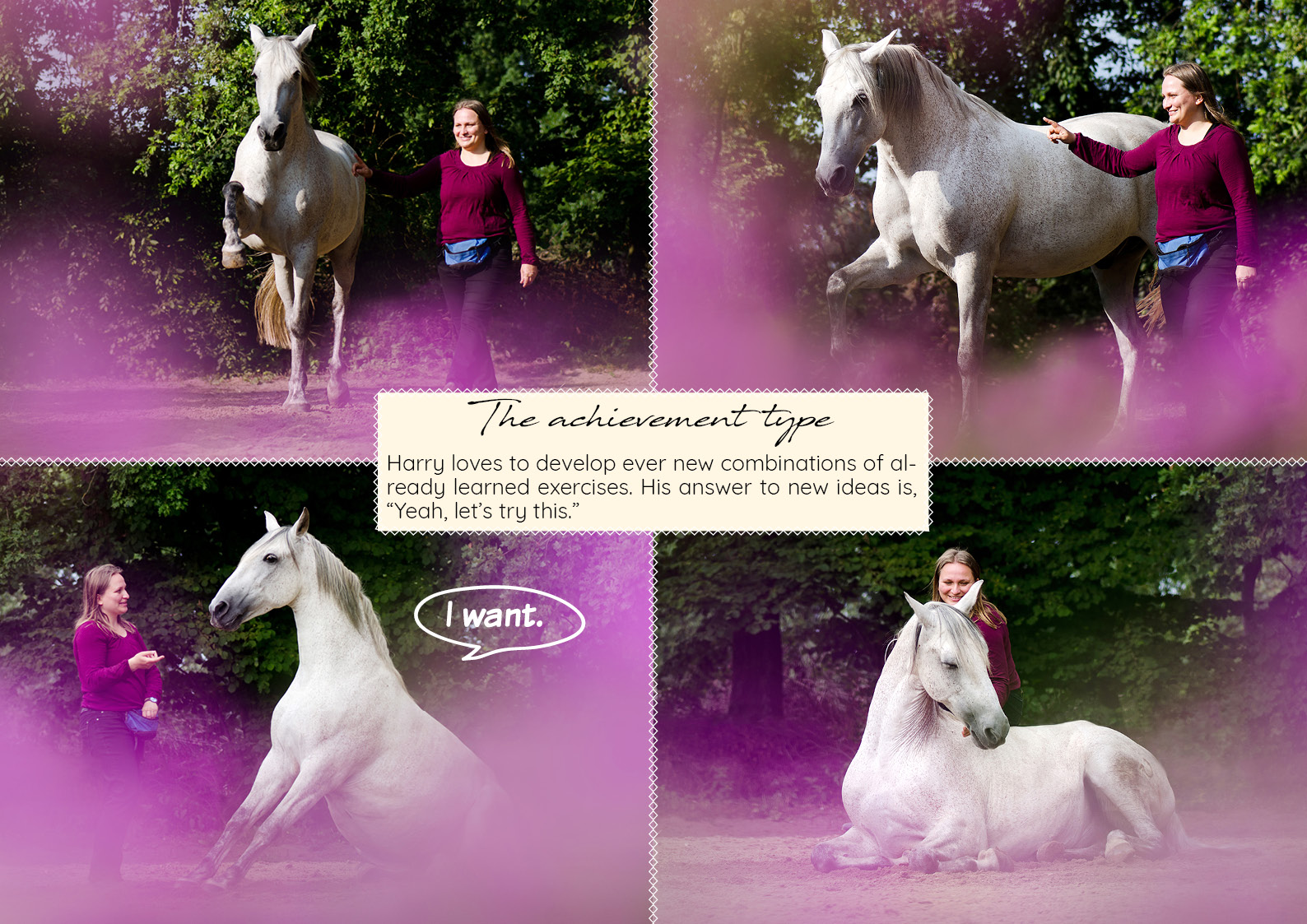
Longing for belonging
Individuals with a very pronounced affiliation motive long for “security, comfort, friendship, relationship and bonding”. Again, these terms should inspire you to form a lively picture of such a personality structure but should not be taken as rigid definitions.
Community
Horses that are governed by the affiliation motive feel best when their contribution is appreciated, when they are recognized, and feel integrated in their community. Individuals with this personality structure just want to be present; they understand themselves as part of a group, and define themselves in terms of being rather than doing. Generally speaking, they avoid taking risks, prefer a well-known environment, familiar tasks, and quickly tend to take mistakes and even a lack of feedback personally. These horses feel rewarded if others authentically take part in their joy, and they aim to increase the feeling of wellbeing within their community.
Where there is light, there must be shadow
Their fears and worries are concerned with being rejected, unpopular, or not loved, and they are afraid of being isolated, excluded or left alone.
Neurotransmitters
The feeling related to these worries is to experience worthlessness. The secretion, or when not excited a lack of secretion, of the neurotransmitter dopamine corresponds to the affiliation motive. Dopamine is frequently related to pleasure, and plays an important role in regulating motivation because it is a substance that increases one’s drive. This motivation type is frequently found among humans who are educators, like team sports or sing in a choir.
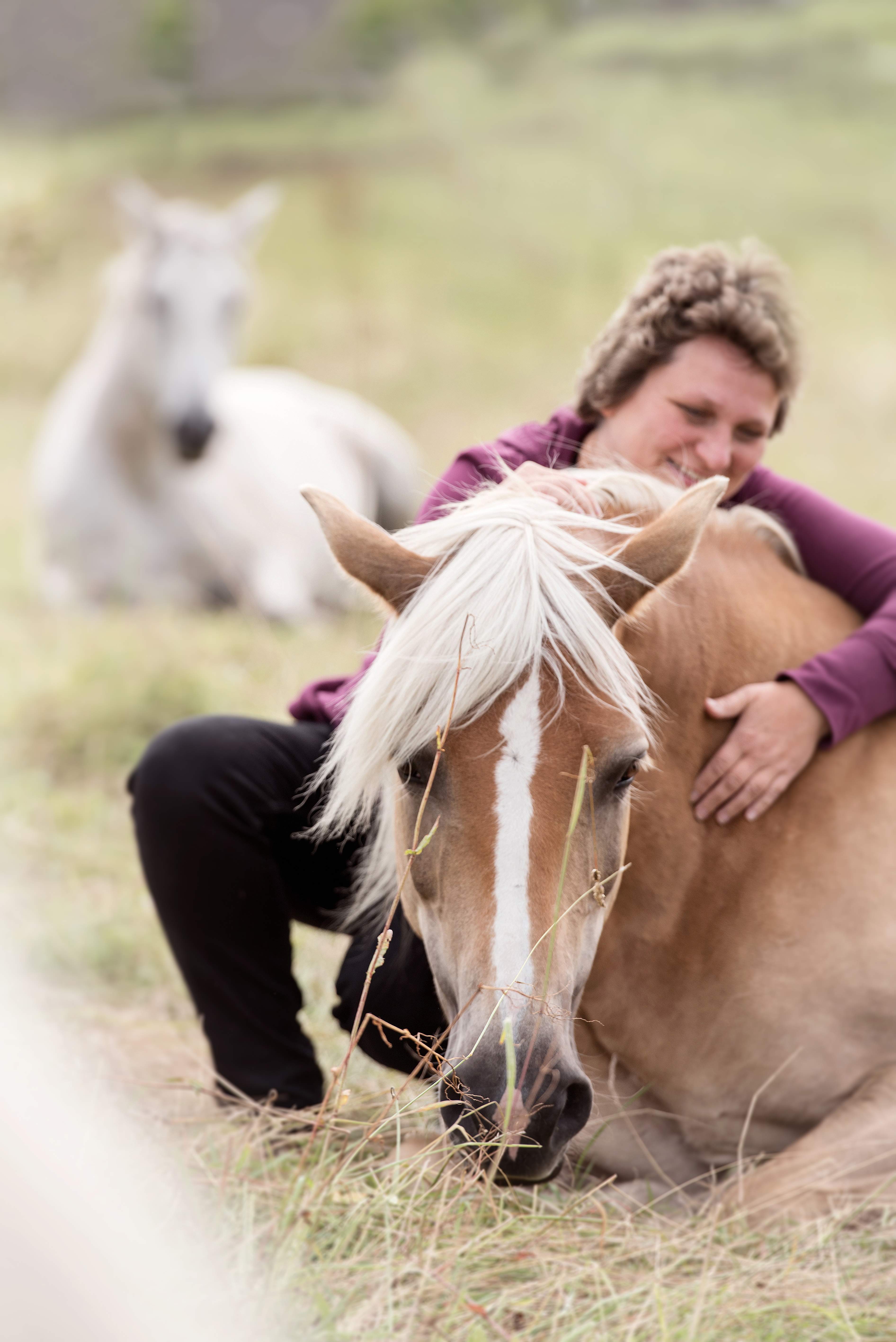
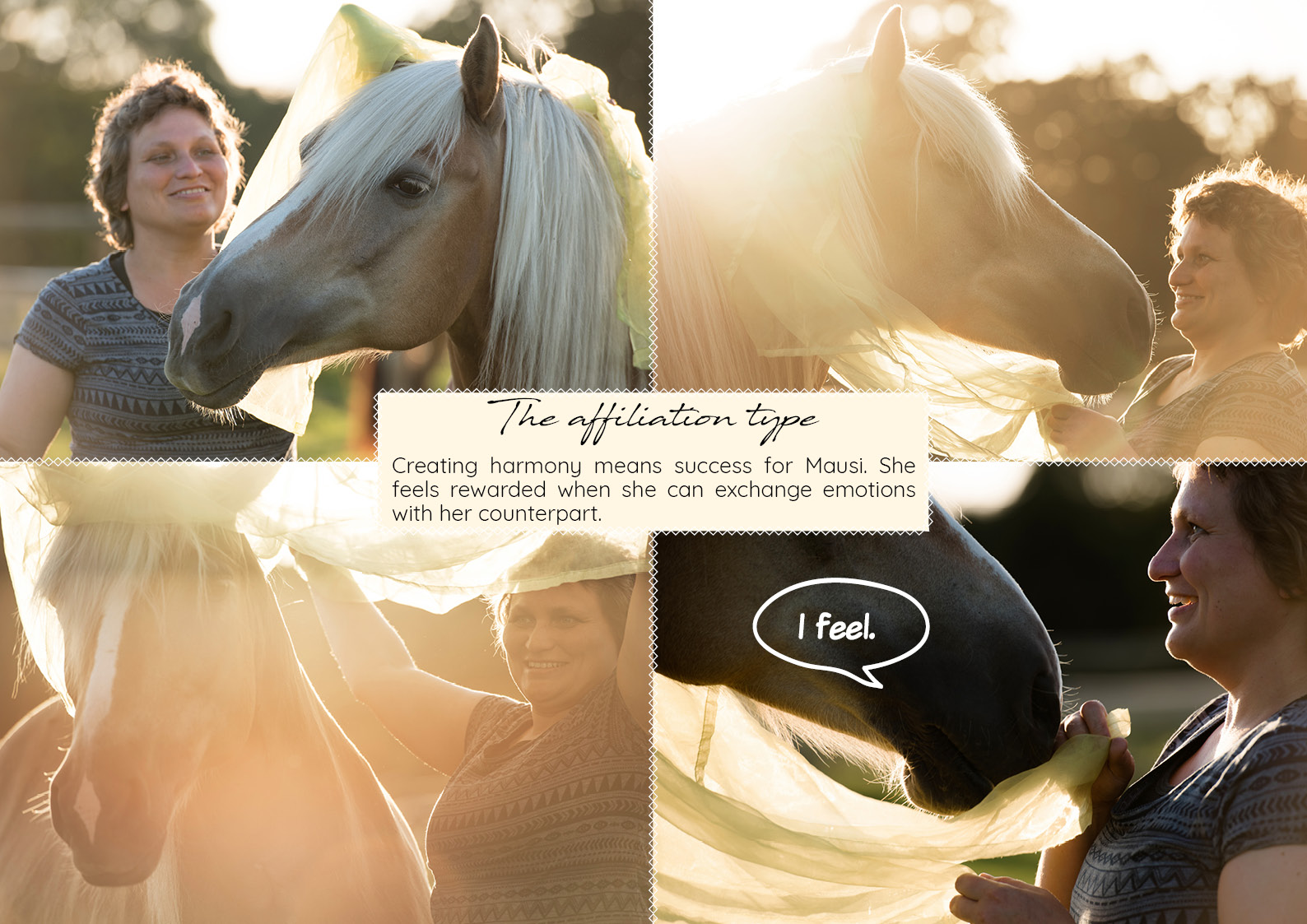
Identify the true motivation
The motive structure, or in other words the amount of activation of each motive in horse and human, can guide us to choose appropriate tasks, training methods and so on. Furthermore, it can help to identify possibly problematic areas in advance. Simply put, we can say that ideal circumstances for our horse which satisfy the basic motives, and adequately stimulate them according to their motivation type, make them happy. In contrast, we create unhappy animals that might even feel stressed by well-meant offers of rewards if we neglect their respective basic needs.
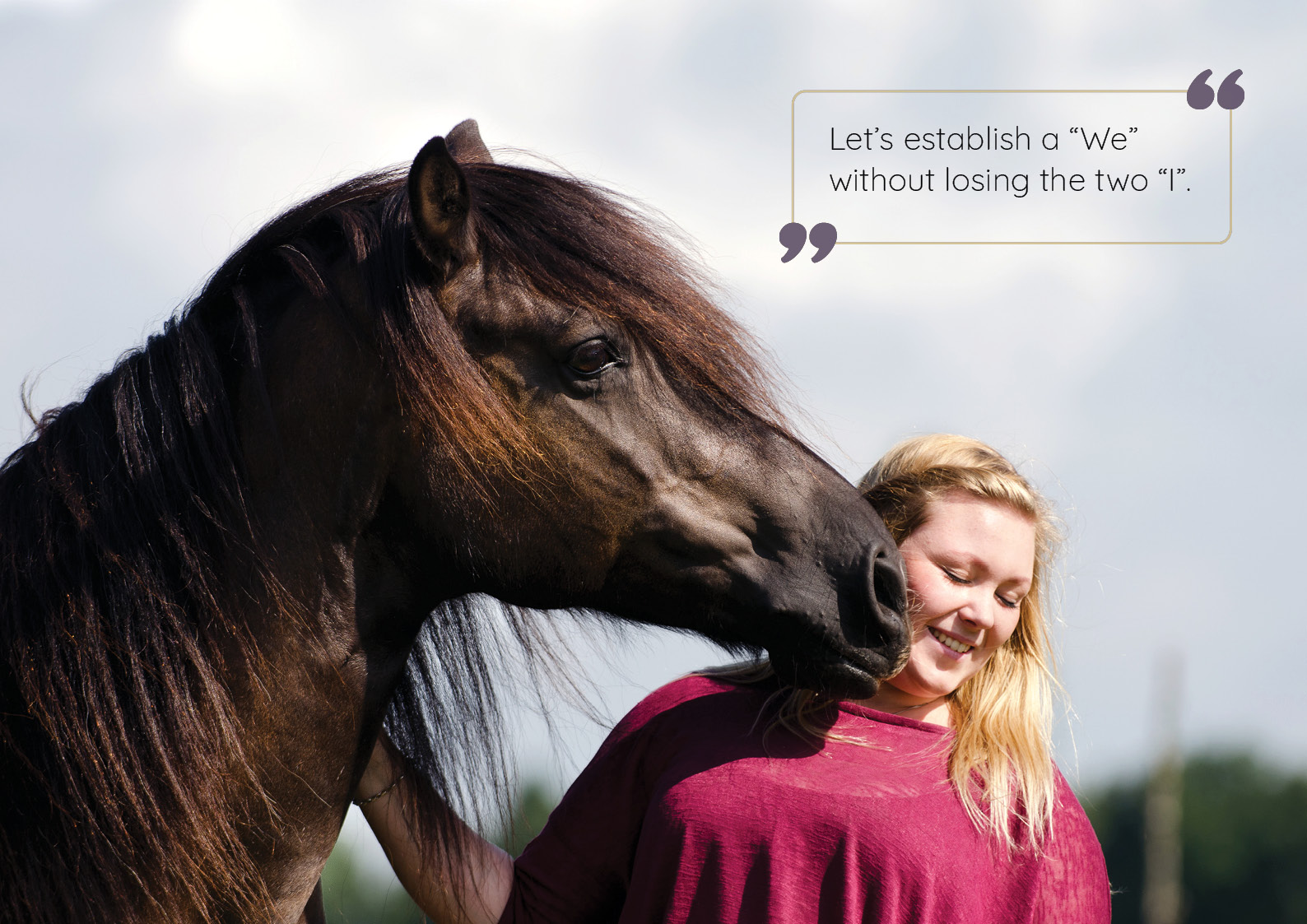
Not set in stone
Of course, these motivation groups are not completely static, and can certainly change throughout life. Yet, in my opinion, it is beneficial to think about them when dealing with positive reinforcement and types of motivation. It is easy to motivate around the true needs of both parts of your team if you do not understand what makes your horse tick, and how and for which reasons you act. So, the following questions can help you to uncover your motivation.
What motivation type am I?
Where do I see my horse?
What are the strengths of our team?
Which problems are involved in this?
Question motives
We, as human beings, can reflect upon our motivations, can question them to a certain extent, or consciously change them. Presumably, horses are less aware of their personality structure. So, it is our task to see them as they are without wanting to change them.
Adjusted Activity
The type of our shared activity should always be adjusted to the type of the respective horse personality. It is not about training this or that lesson but about how we are able to satisfy our horse’s basic motives as well as our own basic motives. Particularly, horse-human teams that are very different need to find individually created reward factors in training lessons. For example, we can reward previously established milestones to satisfy our needs when we are performance-oriented while our four-legged “Sun King or Queen” can become intoxicated with the power to decide completely “on his/her own” as we lead them to believe so.
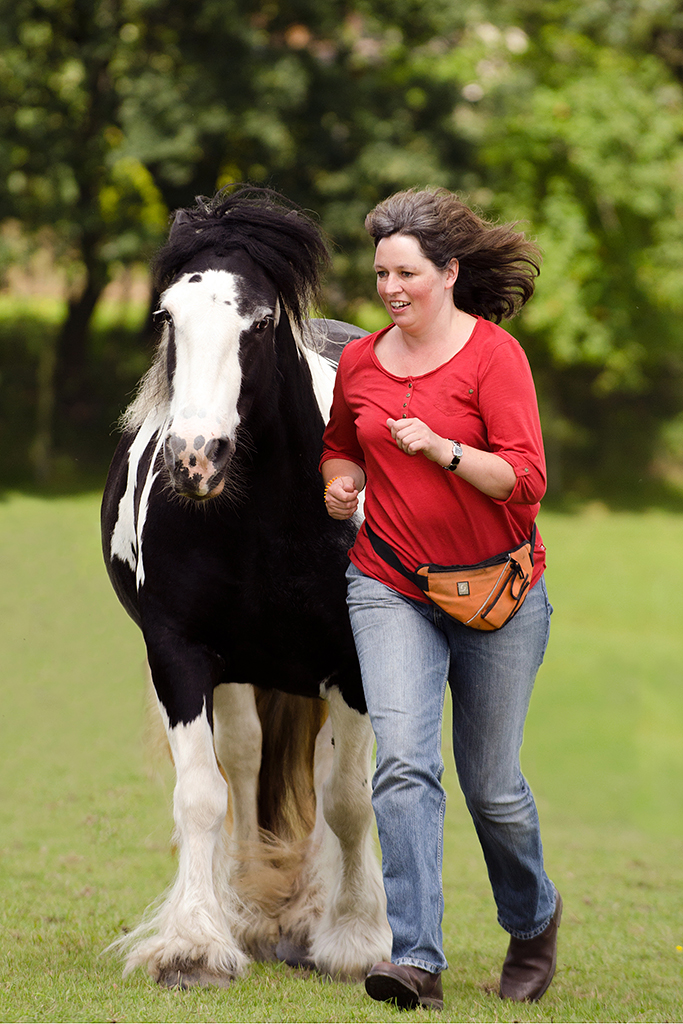
Outlook
This text about the sources of motivation only serves as short introduction to the system of types of motivation, and the following issues will occasionally continue to expand on this topic.
Marlitt Wendt & Conny Ranz

Original work by D. C. McClelland
(1) D. C. McClelland: Human motivation. Cambridge 1987.
(2) D. C. McClelland, R. Davidson, C. Saron, E. Floor: The need for power, brain norepinephrine turnover and learning. In: Biological psychology. Band 10, Nummer 2, März 1980, S. 93–102, PMID 7437489.
(3) D. C. McClelland, Vandana Patel, Deborah Stier, Don Brown: The relationship of affiliative arousal to dopamine release. In: Motivation and Emotion. 11, 1987, S. 51, doi:10.1007/BF00992213.
(4) D. C. McClelland: Achievement motivation in relation to achievement-related recall, performance, and urine flow, a marker associated with release of vasopressin. In: Motivation and Emotion. 19, 1995, S. 59, doi:10.1007/BF02260672.

